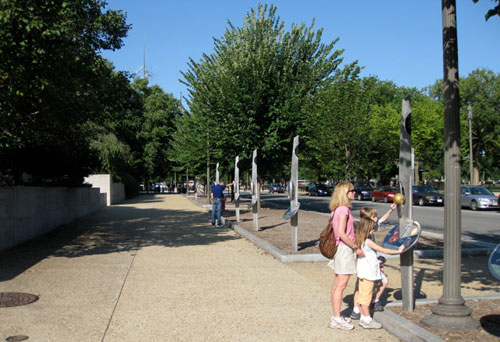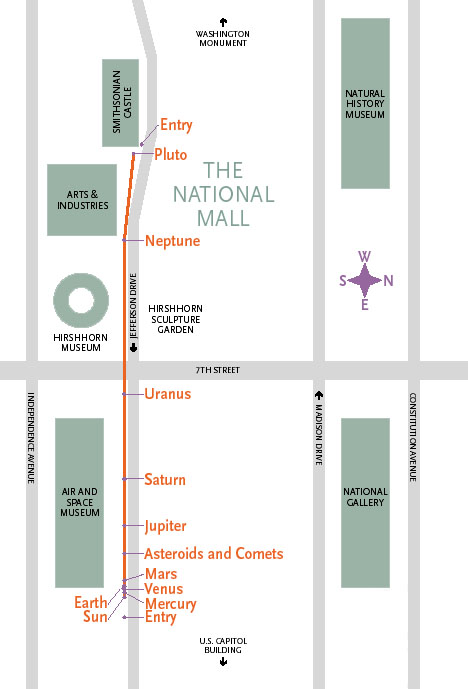
The Voyage Scale Model Solar System in Washington, DC. This photo shows the author’s family at the model Sun, which is the gold-colored sphere. Looking into the distance you can see the pedestals for the inner planets. The National Air and Space Museum is on the left.
Voyage exhibits now opening across the country! Click here to learn more about becoming a Voyage community.
The Voyage scale model solar system opened in October, 2001 on the National Mall in Washington, DC. Voyage depicts the Sun, the planets, and the distances between them all on the same scale of 1 to 10 billion, giving visitors a real sense of the vastness of our solar system (“that’s why they call it space!”). In this way, visitors get a unique perspective on the beauty and fragility of our home planet, on the challenges and triumphs of space exploration, and on the remarkable fact that our species has managed to learn about other worlds. The models, text, and images that constitute the exhibit are designed to make visitors feel like explorers themselves, so that all humans can share in the great adventure of space exploration.
The physical exhibit consists of a set of 8-foot-tall stainless steel stations–one each for the Sun and the planets and Pluto, plus entry stations at either end and a station for asteroids and comets–with both the sizes of the solar system objects and the distances between them shown on a scale of 1 to 10 billion. Each station consists of an informative plaque with striking, scientifically accurate images and a map of the exhibit’s layout along the Mall. Above the plaque, visitors will find a unique three-dimensional, scaled representation of the station’s object (planet or Sun). The exhibit stretches along Jefferson Drive, with the Sun and inner planets (see the photo above) located just outside the northeast corner of the National Air and Space Museum. Heading west along the pathway, you’ll find Pluto just outside the Smithsonian Castle. Note that, on this same scale where you can walk from the Sun to Pluto in just a few minutes, the distance to the nearest other star system (Alpha Centauri) is some 2,500 miles–equivalent to the distance from Washington, DC, to San Francisco.
The Voyage exhibit was developed by the Challenger Center for Space Science Education, the Smithsonian Institution, and NASA. It is now managed by the National Center for Earth and Space Science Education.
- Take a Virtual Tour of Voyage
- Download the Voyage Visitor Guide (PDF)
- Go to the Official Voyage Web Site
- Watch Dr. Bennett lead a tour of the Voyage Mark II model at the University of Memphis.
DC Voyage Map

Become a Voyage Community
One of the major goals of the Voyage project is to make the educational experience of walking a scale model solar system available to everyone. The siting on the National Mall may reach several million people per year, but we hope to reach even more people by building customized Voyage installations in communities around the world. If you are interested in building a Voyage exhibit in your community, please read the information at the official voyage site; if you have questions, contact me and I will direct you to the appropriate people.
A Brief Voyage History
The Voyage exhibit has been a huge undertaking, ultimately involving great efforts by many dozens of people. Indeed, putting Voyage on the National Mall has essentially required going through the same approval process followed by other monuments, such as the forthcoming World War II Memorial. The many people and institutions involved are too numerous to list here, but the efforts of four individuals have been especially critical: Voyage team leader Jeff Goldstein (then at Challenger Center for Space Science Education), along with Carolynne Harris Knox (then at The Smithsonian Institution), Jodi Schoemer (Denver Museum of Nature and Science), and Martha Sewall (then at The Smithsonian).
My own involvement in Voyage began way back in 1981, at a time when I was teaching astronomy to both elementary school children and college students, and recognized the need for a way to convey the true scale of the cosmos. In 1984, three students from my Honors astronomy class at CU–Ken Center, Matt Carter, and Ron Bass–volunteered to help me create a model solar system for the Boulder campus. My Ph.D. thesis advisor, Tom Ayres, volunteered to lead the effort through the university bureaucracy and budgeting, and also ended up doing the physical design and blueprints for the model. The five of us worked together to create the Colorado Scale Model Solar System, which was dedicated in May 1987 to the memory of the Challenger astronauts.
We chose to use a scale of one to ten-billion for three important reasons: (1) although the planets are tiny on this scale, with Earth is only about the size of the ball point in a pen, it keeps the entire exhibit to a size (less than a half-mile long) that can be easily traversed by children and their parents as well as people with disabilities; (2) on this scale a light year is about a thousand kilometers (620 miles), making it easy to extend the scale to understanding the vast distances measured in light-years to stars; (3) because the real size of the solar system differs from scale size by ten zeros, it’s easy for even elementary and middle school children to work with the scale.
Shortly after we completed the Colorado model in 1987, I wrote a letter to the National Air and Space Museum suggesting a similar exhibit for Washington, DC. I did not receive a response. In early 1991, I went to work at NASA Headquarters, then located across the street from the National Air and Space Museum, where I reported to the Director of Astrophysics, Charlie Pellerin. One spring day, he was asking me about the Colorado model, and I mentioned my unanswered letter from four years earlier. He said something along the lines of, “What, you didn’t get any response at all? Let’s go over there and talk to the Director!” We did, and within about an hour, the Director of the National Air and Space Museum (Martin Harwit), Charlie Pellerin, and myself were outside on the Mall, identifying possible locations for the Sun and each of the planets in the model.
Dr. Harwit then realized that the best chance of making the project a reality was to have someone within the museum take the lead, and he brought Jeff Goldstein up to meet us. Jeff Goldstein and I had very similar backgrounds; both of us are the same age, got our Ph.Ds in astronomy at about the same time, and both were in the habit of giving public talks on the scale of the universe; but we had never met. Needless to say, we hit it off immediately. Jeff Goldstein began working very hard on figuring out how to make the project happen, and devoted the larger part of his life over a 10-year period to making Voyage a reality. He was joined almost from the start by Jodi Schoemer, a former student of mine who had helped us refurbish the Colorado model in the early 1990s and upon graduation moved to the National Air and Space Museum to help in the Voyage effort.
It took an incredible effort by Jeff Goldstein and Jodi Schoemer to keep the project alive through the years. At one point, we were very close to getting the go-ahead to proceed to the final approval process (which still meant about 3 years of work!), when Jeff’s entire group was laid off from the Air and Space Museum. The project was then homeless until he and Jodi were hired by the Challenger Center, which graciously offered to be the new lead institution. They then assembled a new collaborative effort with Marty Sewall, Carolynne Harris Knox, and others at the Smithsonian Institution. NASA then joined in as a partner and provided the bulk of the funding for the project, with the key roles there played by Jeff Rosendahl and Frank Owens.
Today, Jeff Goldstein continues to lead efforts to develop Voyage further through a new partnership with the National Center for Earth and Space Science Education (NCESSE). There, he is working toward our long-stated goal of creating customized, educational Voyage installations for 100 or more other sites around the world. Our mission remains to educate the world about how the Earth fits into the solar system and the universe, so that people will better appreciate the importance of taking good care of our planet, of living in harmony with our fellow human beings, and of remaining explorers who will someday learn of the great wonders that await us in the cosmos.
